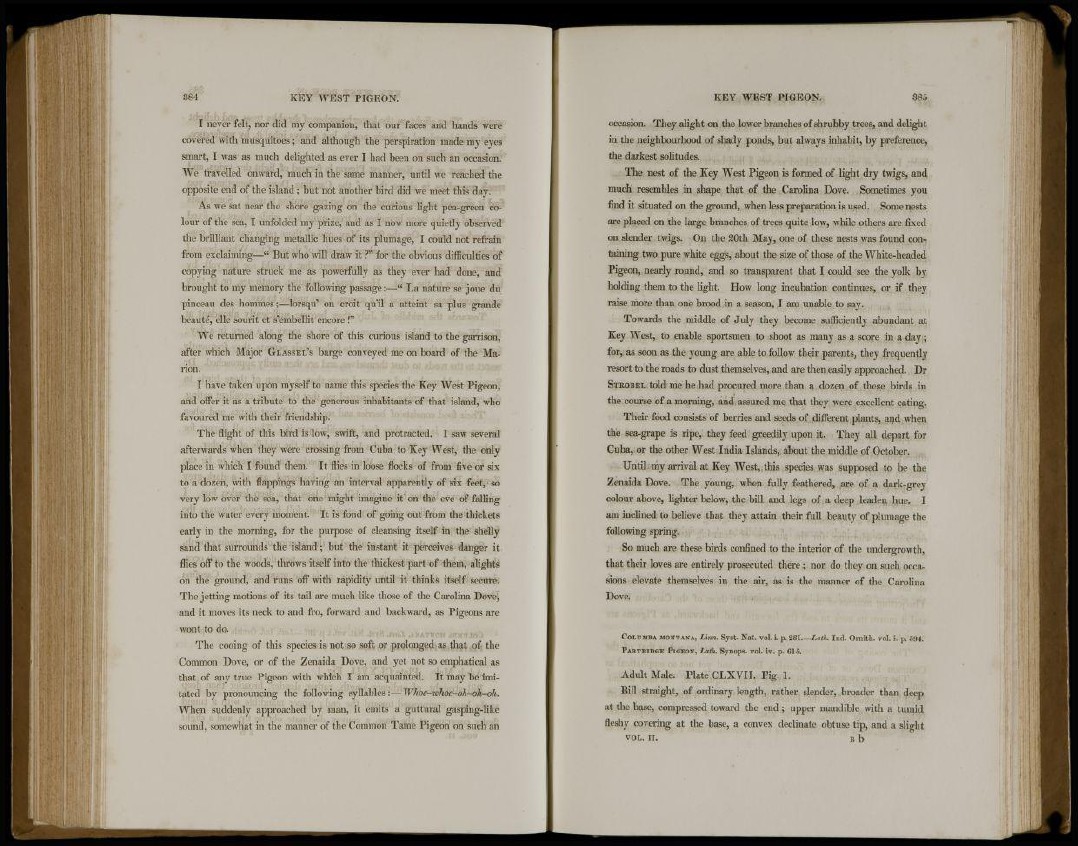
384 KEY WEST PIGEON.
I never felt, nor did my companion, that our faces and hands were
covered with musquitoes ; and although the perspiration made my eyes
smart, I was as much delighted as ever I had been on such an occasion.
We travelled onward, much in the same manner, until we reached the
opposite end of the island ; but not another bird did we meet this day.
As we sat near the shore gazing on the curious light pea-green colour
of the sea, I unfolded my prize, and as I now more quietly observed
the brilliant changing metallic hues of its plumage, I could not refrain
from exclaiming—" But who will draw it ?" for the obvious difficulties of
copying nature struck me as powerfully as they ever had done, and
brought to my memory the following passage :—" La nature se joue du
pinceau des hommes;—lorsqu1 on croit qu'il a atteint sa plus grande
beauté, elle sourit et s'embellit encore r
We returned along the shore of this curious island to the garrison,
after which Major GLASSEL'S barge conveyed me on board of the Marion.
I have taken upon myself to name this species the Key West Pigeon,
and offer it as a tribute to the generous inhabitants of that island, who
favoured me with their friendship.
The flight of this bird is low, swift, and protracted. I saw several
afterwards when they were crossing from Cuba to Key West, the only
place in which I found them. It flies in loose flocks of from five or six
to a dozen, with flappings having an interval apparently of six feet, so
very low over the sea, that one might imagine it' on the eve of falling
into the water every moment. It is fond of going out from the thickets
early in the morning, for the purpose of cleansing itself in the shelly
sand that surrounds the island ; but the instant it perceives danger it
flies off to the woods, throws itself into the thickest part of them, alights
on the ground, and runs off with rapidity until it thinks itself secure.
The jetting motions of its tail are much like those of the Carolina Dove,
and it moves its neck to and fro, forward and backward, as Pigeons are
wont to do.
The cooing of this species is not so soft or prolonged as that of the
Common Dove, or of the Zenaida Dove, and yet not so emphatical as
that of any true Pigeon with which I am acquainted. It may be imitated
by pronouncing the following syllables :— Whoe-whoe-oh-oh-oh.
When suddenly approached by man, it emits a guttural gasping-like
sound, somewhat in the manner of the Common Tame Pigeon on such an
KEY WEST PIGEON.
occasion. They alight on the lower branches of shrubby trees, and delight
in the neighbourhood of shady ponds, but always inhabit, by preference,
the darkest solitudes.
The nest of the Key West Pigeon is formed of light dry twigs, and
much resembles in shape that of the Carolina Dove. Sometimes you
find it situated on the ground, when less preparation is used. Some nests
are placed on the large branches of trees quite low, while others are fixed
on slender twigs. On the 20th May, one of these nests was found containing
two pure white eggs, about the size of those of the White-headed
Pigeon, nearly round, and so transparent that I could see the yolk by
holding them to the light. How long incubation continues, or if they
raise more than one brood in a season, I am unable to say.
Towards the middle of July they become sufficiently abundant at
Key West, to enable sportsmen to shoot as many as a score in a day ;
for, as soon as the young are able to follow their parents, they frequently
resort to the roads to dust themselves, and are then easily approached. Dr
STROBEL told me he had procured more than a dozen of these birds in
the course of a morning, and assured me that they were excellent eating.
Their food consists of berries and seeds of different plants, and when
the sea-grape is ripe, they feed greedily upon it. They all depart for
Cuba, or the other West India Islands, about the middle of October.
Until my arrival at Key West, this species was supposed to be the
Zenaida Dove. The young, when fully feathered, are of a dark-grey
colour above, fighter below, the bill and legs of a deep leaden hue. I
am inclined to believe that they attain their full beauty of plumage the
following spring.
So much are these birds confined to the interior of the undergrowth,
that their loves are entirely prosecuted there ; nor do they on such occasions
elevate themselves in the air, as is the manner of the Carolina
Dove.
COLUMBA MONTANA, Linn. Syst. Nat. vol. i. p. 281—Lath. Ind. Ornith. vol. i. p. ,">!li.
PARTRIDGE PIGEON, Lath. Synops. vol. iv. p. 015.
Adult Male. Plate CLXVII. Fig. 1.
Bill straight, of ordinary length, rather slender, broader than deep
at the base, compressed toward the end; upper mandible with a tumid
fleshy covering at the base, a convex declinate obtuse tip, and a slight
VOL. n. B b